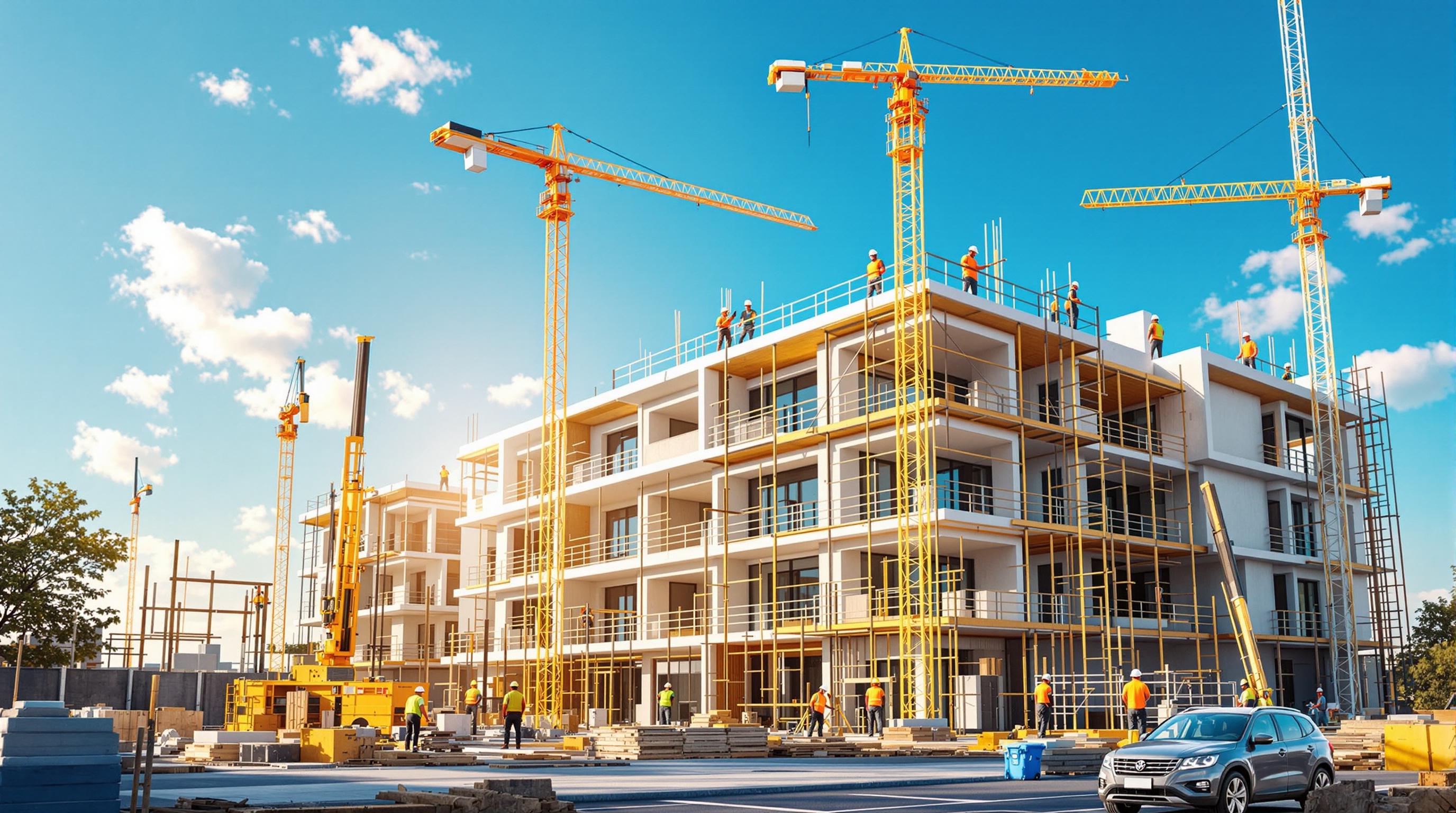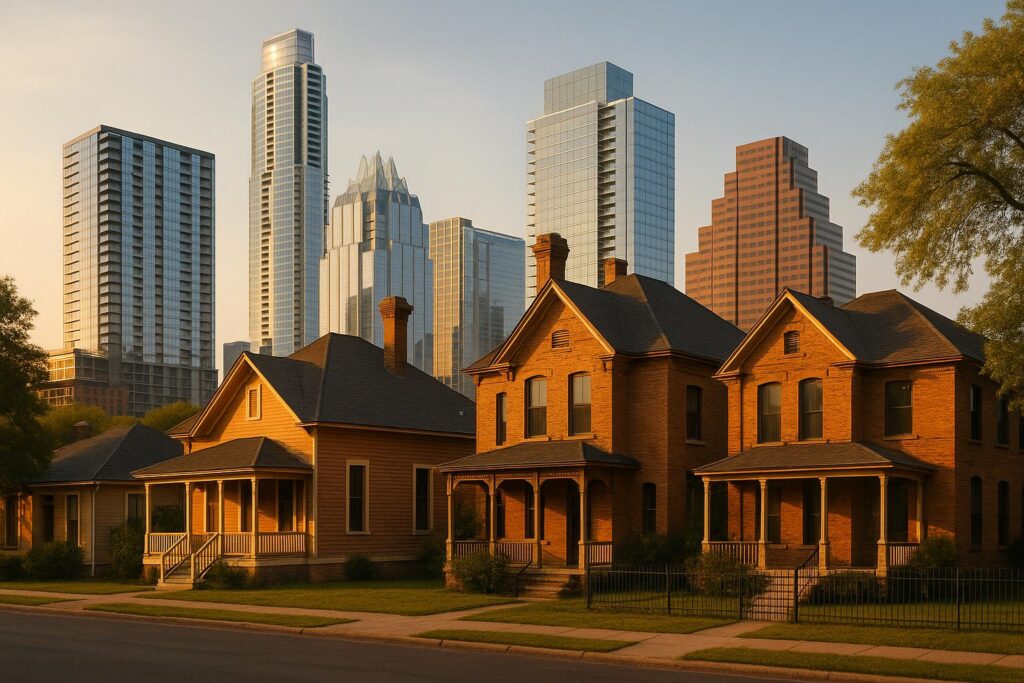Austin’s construction market in 2025 is shaped by five key factors driving up prices:
- Worker Shortages and Wage Increases: A lack of skilled labor is raising wages and delaying projects.
- Rising Material Costs: Global supply chain issues and demand spikes are increasing prices for essentials like lumber and steel.
- Land Costs and Regulations: High property prices, stricter zoning laws, and permit delays add to development expenses.
- Population Growth: Austin’s booming economy and growing population are fueling housing demand and competition.
- Shifting Buyer Preferences: Modern buyers want energy-efficient, work-from-home-friendly, and sustainable designs, which raise construction costs.
These factors are reshaping Austin’s housing market, making it crucial for buyers and builders to plan carefully. Understanding these trends can help you navigate the challenges and opportunities in this dynamic real estate landscape.
Austin Housing Market 2024 vs 2023 – What’s Next for 2025?
1. Worker Shortages and Wage Increases
Austin’s construction industry is facing a lack of skilled workers, which is pushing labor costs higher. Trades such as framers, electricians, and plumbers are in short supply, making it difficult for builders to keep up with demand. These shortages are also causing delays in project timelines.
To address these challenges, many local builders are turning to methods like prefabrication and modular construction. These techniques can help control labor costs while ensuring projects meet quality expectations in a rapidly growing market.
2. Building Material Prices and Supply
The cost of building materials plays a major role in shaping new construction prices in Austin. Lately, essential materials like lumber, steel, and concrete have seen price swings due to global supply chain issues and growing demand. These challenges have made material availability less predictable and extended delivery times, leading contractors to revise both schedules and budgets. To navigate these hurdles, local builders are taking specific steps.
Here’s how builders are tackling these challenges:
- Signing bulk purchasing agreements to lock in steadier pricing.
- Opting for alternatives like engineered wood to reduce dependence on traditional materials.
- Collaborating with Texas-based suppliers to cut down on transportation delays and better manage inventory.
These approaches are helping builders address supply chain disruptions and keep projects on track in Austin’s ever-changing market.
sbb-itb-4c99469
3. Property Costs and Building Rules
Property expenses and regulations are major factors influencing construction costs in Austin, alongside labor and materials. The city’s rapid growth has driven up land values, especially in sought-after neighborhoods.
Property Cost Trends
Land prices in high-demand areas continue to climb, forcing developers to adjust their pricing models. These increases often limit development opportunities in prime locations.
Zoning and Building Codes
Updated zoning laws and building codes – covering energy efficiency, fire safety, stormwater management, and accessibility – add to construction costs. While these updates aim to improve building quality, they also complicate planning and execution. The impact of these regulations varies across Austin, creating different challenges depending on the neighborhood.
Geographic Cost Differences
Areas like Downtown, East Austin, and Northwest Hills come with distinct property costs and zoning complexities. Developers must account for these unique neighborhood requirements, which can significantly influence construction budgets.
Permits and Infrastructure Requirements
Permit delays can lead to higher financing costs, while mandatory contributions for infrastructure upgrades – such as roads and utilities – further increase project expenses.
Navigating these land and regulatory challenges is essential for successful development in Austin. For tailored advice, reach out to the Austin Local Team.
4. Austin’s Growth and Housing Demand
Austin’s booming population and expanding economy are driving up new home prices across the metro area. The city’s rapid growth has put significant pressure on the housing market, affecting both construction costs and home prices. Here’s a closer look at the factors shaping this trend.
Population Growth and Buyer Competition
As Austin’s population grows, so does competition among buyers. This often results in bidding wars, pushing prices higher. This competitive environment heavily influences how builders price new homes and make development decisions.
Economic Expansion and Housing Demand
The city’s thriving economy is a key factor behind new construction projects. With more businesses setting up shop and creating jobs, demand for housing remains strong. This steady need for new homes drives up both construction activity and associated costs.
Shifting Development Patterns
Population growth is also reshaping development trends across Austin’s neighborhoods. Where and how new homes are built depends on the geographic distribution of demand, which impacts land availability and construction expenses in different parts of the metro area.
Austin’s evolving housing market is closely tied to these growth dynamics, making it crucial for anyone involved in new construction to stay informed about these ongoing changes.
5. Home Buyer Needs and Market Changes
As Austin’s housing market grows, buyers’ preferences are shifting, directly influencing home designs and construction costs. Modern home buyers in Austin are looking for features that align with their lifestyles and values, pushing builders to rethink their designs.
Energy-Efficient Features
Energy-saving elements are now a major focus. Builders are adding features like wiring for solar panels, high-efficiency HVAC systems, insulated windows and doors, better insulation, and smart thermostats. While these upgrades come with upfront costs, they help lower utility bills over time.
Work-From-Home Adaptations
With remote work here to stay, home designs now frequently include dedicated office spaces. Standard features often include built-in internet wiring, materials that reduce noise, and layouts that allow for more natural light. Smart technology is also becoming a key part of these designs.
Smart Home Integration
Connected living is a priority for many buyers. Builders are equipping homes with pre-installed systems for security, smart lighting, and home automation to meet these expectations.
Sustainability Focus
Eco-conscious buyers are driving the use of environmentally friendly materials, low-VOC finishes, water-saving plumbing, drought-tolerant landscaping, and rainwater collection systems.
These evolving buyer preferences are shaping the future of home construction costs in Austin, making it essential to stay aligned with market demands.
Conclusion
Austin’s construction market in 2025 is shaped by several factors: worker shortages, rising material costs, stricter building regulations, population growth, and shifting buyer preferences. These elements combine to create a pricing landscape that requires careful planning and smart decision-making.
For buyers, understanding these factors is key to making informed choices. Partnering with knowledgeable local real estate professionals can offer essential guidance to navigate these challenges. Both buyers and builders need to approach this changing environment with clear strategies.
"Austin Local Team was great! Extremely grateful for a real estate agent who was knowledgeable about issues moving from out of state. Good communication and setting expectations with deadlines." – Michael C.
Staying updated on local trends, recognizing the impact of regulations, and preparing for competitive situations are all critical for success in this market. Stories like Dr. Alex M., who purchased an Alandale home below asking price with the help of Tyler’s expertise, highlight how informed buyers working with skilled professionals can still find great opportunities in Austin’s ever-changing real estate market.





